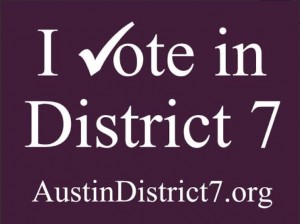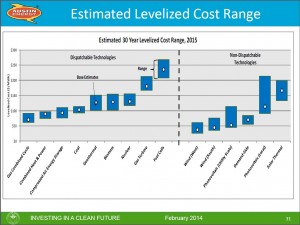Dear Reader,
This first 10-1 city council election is the largest in Austin’s history, and probably in our lifetime. After this first ‘big bang’ election, half the districts will have their next election in two years, and half in four years. Also, most districts will have incumbents, a fact that will limit viable opponents.
It is also a confusing election. The districts are brand new. Most of the candidates, certainly in District 7, are fresh faces. The city has not previously tried to wrestle systematically with local issues. Most candidates will have limited funding to effectively communicate their message. There’s risk of too little information, of poor quality.
AustinDistrict7.org is trying to address this challenge in two ways: 1) as a credible, reasonably balanced source of information about District 7 candidates, and 2) as an evaluator of candidates from a resident and small business perspective. As editor, it’s my job to perform the first function. I have been seeking stories about issues from many perspectives, and I have conducted 2-3 hour interviews with all of the candidates in the race. I’ll be releasing the results of the interviews starting this week and through September.
The other half of AustinDistrict7.org is our editorial board, composed of 13 people from throughout the district. The board has developed a candidate scorecard with ten categories upon which candidates can be evaluated. The board will meet in the first week of October and evaluate the candidates based on that scorecard as a framework. The board will announce their evaluation results by Friday, October 3rd. They may or may not endorse a candidate, but certainly they will provide more insight on candidate strengths for each scorecard category.
Ten of the board members are residents, people active in their respective neighborhood or homeowner associations. The other three seats are reserved for small business owners – 2 from north of 183 and 1 from south. We hope to fill those seats in the coming month.
I’m proud that our project has recruited involved, thoughtful citizens from throughout the district. These are people who have invested hundreds of volunteer hours making our communities better, safer places. Most are current or recent presidents of neighborhood associations. As such, they have more than average credibility because they were elected by their neighbors, and they have perspective on multiple issues that affect their communities. I don’t want to suggest that our board is perfectly representative of the district. For instance, there are some neighborhoods not represented on the board. Renters are under-represented. But we have reached out as much as we could and made a conscientious effort to be geographically diverse.
Our editorial board currently consists of:
Kata Carbone, Allandale
An Austinite since 1977, Kata settled in Allandale in 1984 and has served on various committees of the Allandale Neighborhood Association over the years including bylaws, communication, events, nominations, membership, safety, and zoning, and currently serves as the association’s vice president. A UT-Austin retiree, Kata’s interests include cultural cuisine, genealogy, and exploring the world.
Toni Diaz, Harris Ridge
Toni Diaz has been president of the Harris Ridge Homeowners Association.
Chris Gregory, Wooten
Chris Gregory and his wife grew up in Pflugerville, went to UT, and have lived in Wooten since 2009. Chris is an educator, and enjoys running, cycling, and music. He serves as president of Wooten Neighborhood Association.
Dale Henry, Brentwood
Dale Henry and his wife have lived in Brentwood for over 20 years and have two children. Dale has been on the Brentwood Neighborhood Steering Committee for 10+ years and is current President of the Brentwood Neighborhood Association.
Kernan Hornburg, Walnut Crossing
Kernan Hornburg is a born and raised Austinite and is the proud father of a teenage son. Kernan moved to the neighborhood of Walnut Crossing in 1999 and is President of the Walnut Crossing Neighborhood Association and has been on the board since 2001. Kernan is very active in his community and encourages civic involvement. He serves as Precinct 263 Chair for the Travis County Democratic Party (TCDP), is a member of the TCDP’s Finance Council and has been an avid supporter, advisor and campaign manager for candidates from Austin City Council to the U.S. Congress.
Francoise Luca, Gracywoods
Francoise Luca first came to Austin to attend the University of Texas, and moved away several years after graduating, to purse a marketing career. Francoise returned to Austin in 2003 and purchased a home in Gracywoods. She got involved with the River Oaks Elementary PTA, and went on to participate in the middle school and high school PTA’s serving on the board and holding other key positions. Francoise is an active member of St. Albert the Great Catholic church where she co-chairs a large social ministry. She also co-owns a finance company and a popular business Meetup group. Francoise is currently serving her third term as president of the Gracywoods Neighborhood Association.
Robert Meadows, Walnut Creek
Robert Meadows is president of the Walnut Creek Neighborhood Association.
Elizabeth Ray, North Shoal Creek
A resident of North Austin since 2004, Elizabeth Ray’s community involvement has included urban development, education, and promoting opportunities for young athletes. She has served the community as a North Shoal Creek Neighborhood Association (NSCNA) Development Committee member, Math Pentathlon club leader, advisor to the board of the Trojan Youth Lacrosse Association, and is currently the NSCNA president. As an information technology project manager (IT PM) for many years, Elizabeth has had the opportunity to prove capability in organizing resolution of issues across diverse stakeholder groups.
Mary Rudig, Gracywoods, editor of the North Austin Community Newsletter
Mary Rudig moved to Austin in 1992 and rented in North Austin (the Skyview and NACA neighorhoods). In 2007, Mary and her husband bought a house in North Quail Hollow, which is part of the Gracywoods Neighborhood. Mary has been a Block Captain for the Gracywoods Watch since 1998, and is also the current CLASP Watch Trainer for North Austin. In her spare time, Mary is the web administrator for www.lovenorthaustin.com and the current editor for the North Austin Community Newsletter, a citizen-led e-newsletter that has been serving North Austin neighborhoods since December 2007.
Steven Walden, Scofield Farms
Steve Walden is a past president of the Scofield Farms Homeowners Association.
Please keep reading our site. Send me feedback. And consider buying a yard sign so more people know about our service. THANK YOU!


